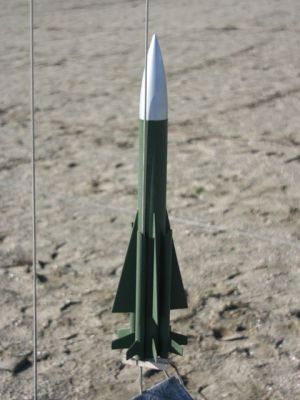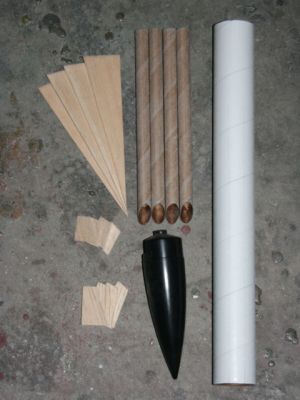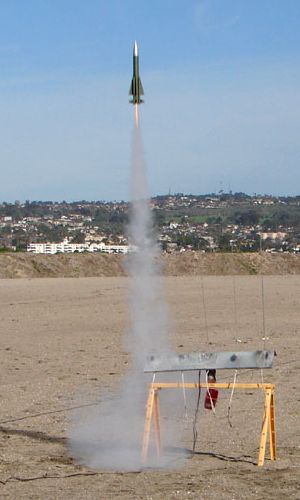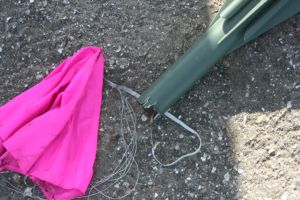Scratch SA-5 Gammon (24mm) Original Design / Scratch Built
Scratch - SA-5 Gammon (24mm) {Scratch}
Contributed by Todd Mullin
| Manufacturer: | Scratch |

Brief:
For the Upscale/Downscale task for the EMRR 2008 Challenge, I found myself stumped for ideas. I didn't want to do a
large upscale, so I had to look for a rocket that was fairly large to start with. Lots of companies are putting out
large sounding rockets, but these are all fairly plain and too simple.
After spending some time surfing through the EMRR search of scale kits, I stumbled upon the OOP Blackhawk R&D SA-5 Gammon. The original kit is a monster cluster of 29mm and 38mm motors. Lots of tubing and lots of motors! This made it a great subject for downscaling.
Because I didn't have one of these kits available to scale from, I had to rely on the accuracy of the RockSim file that was posted with the kit review. By comparing the OD (outside diameter) of the original side pods (1.5") with that of the BT-5 tubing (0.544") I was able to see that my downscale was going to be 36.3% size of the original kit.
Construction:
By starting with my scaling based on BT-5 tubes for the pods, I was able to scale the rest of my tubing. The parts
required are:

- 4 7.875" BT-5 tubes cut with a 45 degree miter on one end
- 1 14.5" BT-60 (slightly large, but it's the closest commercially made tube)
- 1 3" x 8" x 3/32" Balsa sheet
- 1 3" x 6" x 1/16" Balsa sheet
- 1 PNC-60 Cone (not sure of exact designation as it came in a mixed pack)
- 1 3" BT-50 motor mount
- 2 centering rings
- 1 Motor hook
- 1 18" nylon parachute
- 1 12" Kevlar® shock cord
- 1 18" x 1/4" elastic shock cord
- 1 2" x 1/8" Launch Lug
Since I had nothing for reference on the OOP Blackhawk R&D kit other than a few photos and the RockSim file, the first thing I had to figure out was how to get the fin patterns reduced. As they were too big to print out on even an single 11" x 17" sheet of paper, I printed them to a large format PDF from RockSim. I imported the PDF into Adobe Photoshop and scaled the patterns down to 36.3% and then printed them.
In my search for reference material on the kit, I found a large number of photos of the real missile. The nose cone for the kit isn't quite the right profile. It's taper is much longer than the real cone. However, I thought to myself, I did have a BT-60 cone in my box of spare parts that was much closer to the correct profile. By shortening the cone though, the body tube needed to be lengthened to keep the same overall length.
Now that I had all my parts collected, I started by cutting out the fins. The main fins I cut from the 3/32" stock and the small tail fins I cut from the 1/16" stock to try and eliminate as much weight from the tail section as possible. I then sanded and shaped all of the fins to an airfoil.
I used VCT to generate the pattern for the mitered BT-5s and trimmed the tubes to length.
I next attached the fins to the main airframe and the small fins to the pods. After the glue had cured, I attached the pods to the main body. Looking at the rocket, I was hit by the idea that I should put the launch lug on the inside of one of the BT-5 pods to hide it from view.
Up to this point, I was defying the "normal" building order for most kits. I was nearly finished with the construction of the model and I had not yet put together the motor mount! I had held off until the end of the build on purpose as I was not sure how heavy the finished model would be. I decided after the main portion of the building was complete that whereas I could probably get away with a 18mm motor mount, a 24mm mount would be a safer bet.
I next put together a typical motor mount with rings, hook and thrust block. I tied the Kevlar® shock cord to the front of the engine hook before gluing the forward centering ring in place. After a couple of thick fillets were added, the mount was set in place and construction was complete!
Finishing:
The biggest drawback to building a SA-5 Gammon is the large number of fins to sand and seal. 12 of the little guys...
At least with a model of this scale there isn't must lumber involved.
After filling the fins and tube spirals with thinned Elmer's Wood Filler, I gave the model a good coat of Kilz primer and sanded it completely.
There seemed to be several "standard" paint schemes for the Gammon, most of which are either light gray or white. I did find several pictures of one with an olive drab body with a silver cone that I liked for my reproduction. I had some left over decals from another scale build that I had completed recently so I added a few stripes and access panels with these.

Flight:
As this was a scratch build, there was no recommended motor. The SA-5 felt pretty light so I decided to go with my
gut feeling and use a C11-3. I loaded the motor up and added a couple handfuls of dog barf wadding and packed the chute
in. The nose was a little loose so I added a wrap of masking tape.
Before flying, I did a swing test. Despite having 12 fins and pods acting as tube fins, the Gammon tumbled badly. I added about a cubic inch of modeling clay to the nose and it straightened right out.
The rocket blasted off the pad in a hurry on the C11, but the very nice straight boost was cut terribly short by the ejection! I could tell that there were going to be problems as soon as it popped because the rocket had barely begun to coast... Also of note, the motor clip did not keep the casing on board. It came tumbling down on it's own.
Recovery:
The ejection was much too soon on this flight and the airframe paid the price for my incorrect choice of motors. Even
though I had taped the Kevlar®
line before the flight, there was a good size zipper. It looks like a D12-5 or even a D12-7 would be a better choice
for this lightweight rocket.
 The 18" chute seems to be about the right size. The rocket came down slow
and suffered no landing damage.
The 18" chute seems to be about the right size. The rocket came down slow
and suffered no landing damage.
The zipped looks as though it should be fairly easy to repair with some scrap tubing and a coupler so the Gammon will fly again!
Summary:
I enjoyed building this rocket as I have always liked the look of the missiles of Russia. Downscaling the Blackhawk
R&D kit made it much easier as I didn't have to deal with figuring out the exact fin shapes. The model was a very
quick build, only taking a few nights to assemble and paint.
The main drawback to the rocket is the large number of fins to get correctly aligned and then filled.
This rocket could be a fun clustering project if you didn't mount the launch lug on the inside of one of the booster pods.
Sponsored Ads
 |
 |











